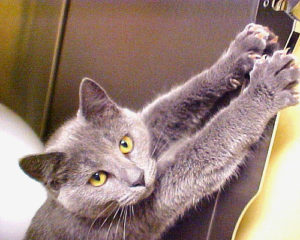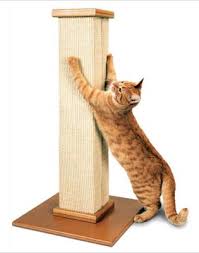
Scratching is a natural behavior for cats. You can’t train them not to do it, nor would you want to. It helps to shed old nail sheaths and keeps nails healthy. Pheromones are released through the paws and the scratching motion leaves their scent behind for other cats to smell. You’ll see declawed cats do the same motion.
I’ve heard many times that people think having a cat automatically means your furniture will be scratched. This is not true. Cats only scratch furniture if they don’t have something else more preferable to use. Scratching up your furniture, rugs, or other undesired item is a behavior problem that can be retrained. The first step is to figure out what your cat prefers.
Cats tend to be either horizontal or vertical scratchers. Look at what they’re scratching now. Is it the side of your couch? That’s probably a cat with a vertical preference. Is is a rug, or the blanket on your bed? That would probably be a horizontal preference. You’ll want to supply good scratching options to match.
Scratchers don’t have to be expensive. Most will love the cardboard kind that come in both horizontal (CLICK HERE) and vertical options. (CLICK HERE) They can be a little messy, but they’re reasonable and easily replaceable. Other good options have sisal wrapped around them or carpet. You can even make one yourself wrapping left over carpet pieces around a piece of wood. Here’s a link to a DIY option. CLICK HERE
It’s important to make sure the scratchers are steady and sturdy. Cats may not use them if they fall over, or move along the floor as they scratch. This is a particularly sturdy one I like. CLICK HERE. On wood floors if they slide, trying placing them against walls or something else that will help hold them in place. Your cat may not care either way, but it’s something to be aware of if you notice they’re not being used.
Place the scratchers near the areas your cat was scratching destructively. If it’s a horizontal surface, put the new scratcher right on top of it. For vertical, place next to it. Add them in high traffic or desirable areas. Master bedrooms are often a trigger area for cat conflicts. Having a scratcher just inside or outside the bedroom door may be another good location. Sprinkle with some catnip. Most scratchers come with some for that purpose. It will attract the cat to it and may stimulate scratching behavior.
It’s also good to get your cat’s’ scent on it, as they will do from the pheromones in their paws. Do not forcefully rub your cat’s paws on it yourself. Aside from the fact that the cat won’t know what you’re doing, you will associating the new scratcher with fear and something unpleasant. Instead, use a clean washcloth, preferable washed with an unscented detergent, and use that to gently rub around your cat’s front paws. Then, rub the washcloth on the scratcher. That will add the pheromone smell in a much more pleasant manner for everyone.
Now that the appropriate items are in place, it would be wonderful if kitty just started using them and you both live happily ever after. But, that’s probably not what’s going to happen. You now have to cover the inappropriate items previously scratched. The old items need to become unpleasant or unavailable to begin the training process. For couches, double sticky tape is a great option. It won’t damage the fabric, and the cats will not enjoy scratching that at all as their paws will stick.
They sell commercial products for cats like this one – CLICK HERE but any double sided tape you can buy in a hardware store would accomplish the same thing.
.Another option is upside down carpet runner. CLICK HERE. This can be put on a vertical or horizontal surface. You want to place it with nibs up. Cats will not like the feel (helps with some litterbox problems too for the same reason). Anything like this will work. I once found a shower mat in a discount store that had thin bristles on it intended as foot massagers. It did a great job solving a cat behavior problem for all of about $3.
For horizontal areas like rugs or blankets, you can put tin foil over them or stack metal cans that will fall over when the area is approached. For more stubborn problems, you can put up motion sensing items like forced air. It will likely only take one or two tries before your cat never goes near that area again. Here is a cat deterrent for that purpose. CLICK HERE.
I want to stress that in no way should you punish your cat if you catch him scratching the inappropriate locations. Squirting with water, or any kind of physical punishment, aside from being cruel, simply does not work. They will not understand the connection and it will damage the relationship you have with your cat. You want deterrents to be quick in response (less than a second), certainly painless, and seemingly not connected to you in any way.
As you continue to discourage the old scratching locations, and keep the new ones attractive to your cat’s needs, you’ll soon be able to enjoy furniture that is all in one piece again.
Please note that I only recommend products that I use myself and feel can be helpful in working to solve various behavior issues. As an Amazon Associate, I do earn from qualifying purchases. There is no additional cost to you in any way.



